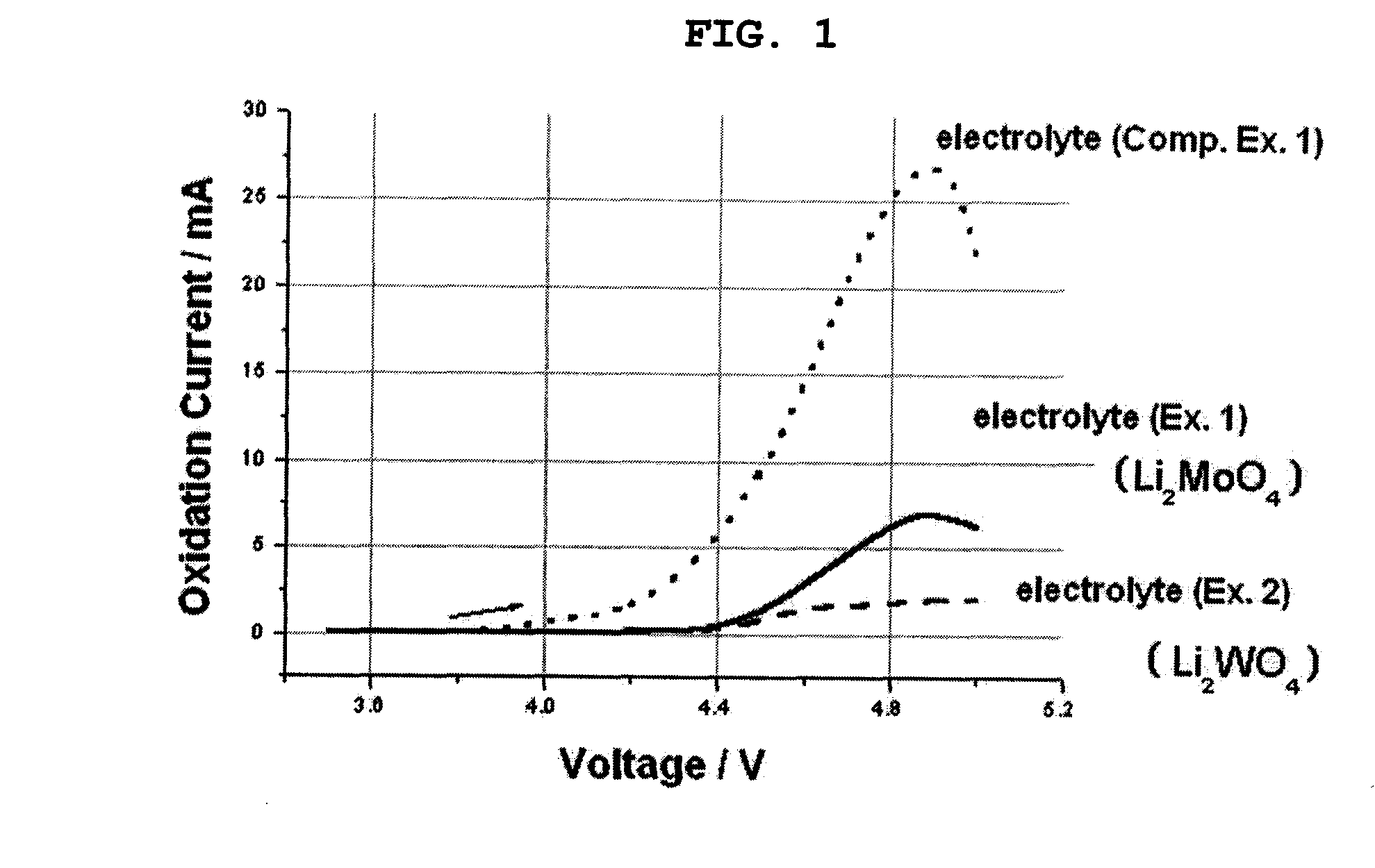[0007]Therefore, the present invention has been made in view of the above-mentioned problems. The present inventors have found that when a
metal oxide salt, which is dissolved and dissociated in a non-
aqueous electrolyte solvent to generate oxyanions having an activity of inhibiting oxidation (corrosion) of metallic materials, is used for forming an electrolyte, it is possible to inhibit corrosion of metallic materials forming an electrochemical device, such as a metallic can and a collector, and to prevent the electrochemical device from being degraded in its quality by corrosion of metallic materials.
[0012]Unlike conventional oxides (U.S. Pat. No. 5,168,019), which are comprised of covalent bonds and thus are not dissociated in an electrolyte solvent, the above-mentioned metal oxide salt is comprised of ionic bonds, and thus is dissociated with ease when it is dissolved in an electrolyte solvent currently used in a battery. Moreover, the metal oxide salt can generate oxyanions, after the dissociation, and such oxyanions can improve the corrosion resistance of metals. The oxyanions significantly reduce the possibility of corrosion of metallic materials, which otherwise increases under abnormal conditions, such as overcharge, overdischarge and high-temperature storage conditions. Therefore, the oxyanions generated from the metal oxide salt can prevent degradation in the quality of an electrochemical device, caused by corrosion of metallic materials present inside the device.
[0013]One component forming the electrolyte according to the present invention is a binary or multinary metal oxide salt. There is no particular limitation in the metal oxide salt, as long as it is comprised of ionic bonds and is ionizable in water and / or organic solvents. As described above, the metal oxide salt is dissociated into oxyanions when it is dissolved in an electrolyte solvent currently used in a battery, and such oxyanions are adsorbed on a protection film generally formed on the surface of a metallic can and / or collector. For example, such oxyanions are adsorbed on defects present on an oxide film. It is thought that such adsorbed oxyanions prevent any oxidation generated from the defects. Therefore, it is possible to solve the problems caused by corrosion of the metallic materials. Such problems include self-
discharge, a drop in capacity, internal
short circuit and an increase in
internal resistance of an electrochemical device, preferably of a battery. Further, it is possible to prevent degradation in the battery quality and damages of the battery.
[0020]Non-limiting examples of the multinary metal oxide salt represented by formula 1 include: Li4SiO4, Li2B4O7, Li2MoO4, Li2WO4, Li2CrO4, Li2TiO3, Li2ZrO3, LiTaO3, LiNbO3, Na4SiO4, Na2B4O7, Na2MoO4, Na2WO4, Na2CrO4, Na2TiO3, Na2ZrO3, NaTaO3, NaNbO3, Cs4SiO4, Cs2B4O7, Cs2MoO4, Cs2WO4, Cs2CrO4, Cs2TiO3, Cs2ZrO3, CsTaO3, CsNbO3, Mg2SiO4, MgB4O7, MgMoO4, MgWO4, MgCrO4, MgTiO3, MgZrO3, Ba4SiO4, BaB4O7, BaMoO4, BaWO4, BaCrO4, BaTiO3, BaZrO3 and mixtures thereof. Particularly, when a
lithium-containing metal oxide salt is used as the multinary metal oxide salt, it is possible to minimize degradation in the quality of a battery, caused by using the additive for electrolyte, because a higher concentration of lithium ions is available for electrochemical reactions occurring in the battery. In addition to the above-described salts, any compounds may be used in the scope of the present invention regardless of their elements or configurations, as long as they are dissolved in a non-
aqueous electrolyte solvent and generate oxyanions so as to serve to inhibit corrosion of metallic materials.
[0032]There is no particular limitation in the shape of the electrochemical device according to the present invention. The electrochemical device may be a cylindrical can-type, prismatic, pouch-type or a
coin-type electrochemical device. Particularly, a cylindrical device comprising a metallic can connected with an
anode of a battery is preferred, a cylindrical lithium secondary battery being more preferred. In the latter case, the effect of preventing corrosion of the metallic can, derived from the multinary metal oxide when the battery is exposed to overcharge, overdischarge or high-temperature storage conditions, is more significant compared to other batteries having different shapes.
 Login to View More
Login to View More  Login to View More
Login to View More 
